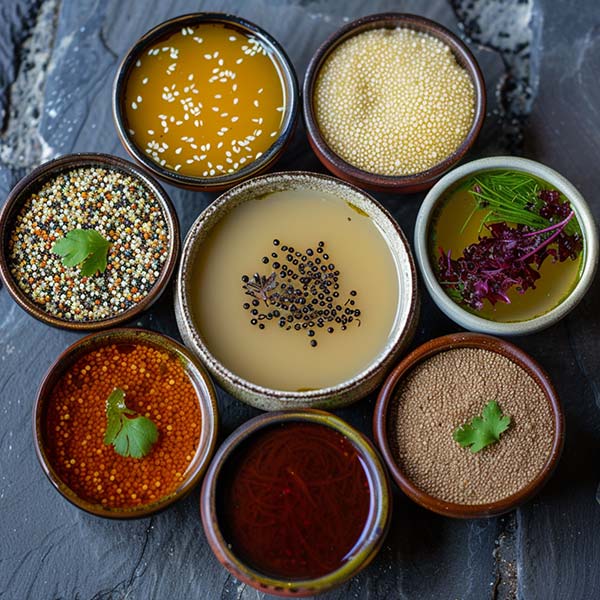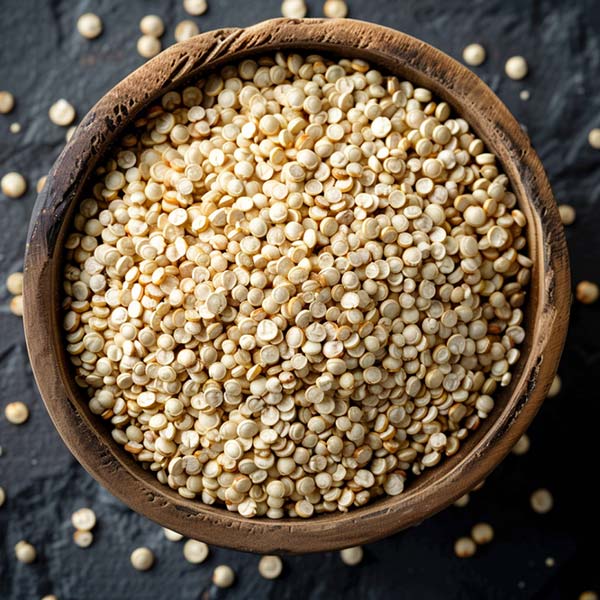Wait, you can cook quinoa in a rice cooker?" Yes, you sure can! It's wonderful to have an appliance that can pull double duty! Just like a rice cooker takes the guesswork out of cooking rice and frees you up to tend to other things, it can also help you make the perfect quinoa!
Cooking quinoa in rice cookers can result in perfectly fluffy quinoa like other methods like instant pot or regular saucepan. Before you embark on cooking quinoa in a rice cooker, it's essential to familiarize yourself with a few key considerations. Below, we'll ensure you know all those things and give you step-by-step instructions on how to cook quinoa in a rice cooker so you can get perfectly cooked quinoa.

How to Make Rice Cooker Quinoa
Prep Time
5 minutes
Cook Time
30 minutes
Rest Time
N/A
Total Time
35 minutes
Ingredients
Directions
1. To prevent sticking, grease your rice cooker by rubbing a tablespoon of the oil you choose all around the interior of the rice cooker insert. While this step is optional, it is highly recommended for anyone using a rice cooker as it is prone to sticking, as these small grains are prone to sticking to the bottom rice cooker insert.
2. You will have to wash quinoa in cold water, using a fine mesh strainer, like white rice, until the water runs clear.
3. Place the rinsed quinoa into the rice cooker insert.
4. Add water, salt, and the liquid of your choice.
5. Power on the rice cooker and select the settings. Let it cook, and it should take about 15-30 minutes, depending on the type of quinoa you are cooking.
6. When you get an alert that your rice cooker has finished cooking, allow the quinoa in the rice cooker to rest for a few minutes to absorb any excess water. Then use a fork to gently fluff the grains, separating them to achieve a light and fluffy texture.
7. For optimal results, let the cooked quinoa cool for approximately 30 minutes before incorporating it into any quinoa recipes. This allows it to reach a suitable temperature and ensures the best texture and flavor.
Tips
Rinse the Quinoa: Prior to cooking, thoroughly rinse the quinoa under cold water to eliminate its natural coating, saponin. This compound can impart a bitter or soapy taste. Utilize a fine mesh strainer for this rinsing process.
Add Flavor: You can enhance the flavor of your quinoa by using vegetable or chicken broth instead of plain water. This adds depth and richness to the final dish.
Salt and Seasoning: Add a pinch of salt or your favorite seasonings, like garlic powder, to the cooking liquid for extra flavor. Herbs like thyme, rosemary, or bay leaf can be added for a fragrant touch.
Select the Right Setting: Many modern rice cookers have a specific setting for cooking grains like quinoa. If your rice cooker has a similar option, use it for the best results. If not, the regular "white rice" setting often works well.
Nutritional Facts
Nutrition Facts
Servings: 4
Calories
187
% Daily Value*
Total Fat 6.1g
8%
Saturated Fat 0.8g
4%
Cholesterol 0mg
0%
Sodium 6mg
0%
Total Carbohydrate 27.3g
10%
Dietary Fiber 3g
11%
Total Sugars 0g
Protein 6g
Vitamin D 0mcg
0%
Calcium 24mg
2%
Iron 2mg
11%
Potassium 240mg
5%
*The % Daily Value (DV) tells you how much a nutrient in a food serving contributes to a daily diet. 2,000 calorie a day is used for general nutrition advice.
What Is Quinoa?
First, this edible seed is traditionally grown in South America. Yes, you read that right—quinoa might look like a grain and cook up like rice, but it's a seed! In fact, quinoa belongs to the same plant family as chard, beets, and spinach, but it is completely protein. This means it contains all the essential amino acids your body needs.
Quinoa's flavor resembles brown rice, with a pleasant nutty undertone and a natural, earthy aftertaste. Like white rice, quinoa cooks by hydration. This versatility is especially handy as quinoa is frequently used as a rice substitute in various dishes. Cooked quinoa is perfect for meal prep and best paired with savory dishes.
Types Of Quinoa And How Long To Cook Them In A Rice Cooker
White Quinoa (Also Called Ivory, Blond, Tan, Or Yellow Quinoa): This is the most common type of quinoa with a mild flavor. Cook white quinoa in a rice cooker by adding 1 cup of quinoa to 2 cups of water and cook for approximately 15-20 minutes.
Red Quinoa: Red quinoa offers a delightful, slightly nutty flavor and maintains its shape beautifully after cooking. To prepare red quinoa in a rice cooker, simply combine 1 cup of quinoa with 2 cups of water and cook for approximately 20-25 minutes.
Black Quinoa: Black quinoa has a rich, earthy flavor and a slightly crunchy texture. To cook it, add 1 cup of quinoa to 2 cups of water and cook for approximately 25-30 minutes in a rice cooker.
Tri-Color Quinoa: This variety combines white, red, and black quinoa, offering a pleasant visual appeal and a mix of flavors. Cooking tri-color quinoa in a rice cooker is a breeze. Just follow the same ratio as white quinoa, combining 1 cup of quinoa with 2 cups of water. Cook it in the rice cooker for approximately 15-20 minutes, and you'll have perfectly cooked tri-color quinoa ready to enjoy.
Types Of Liquid To Cooking Quinoa

When cooking quinoa, it's best to use liquid that adds flavor and enhances the dish's overall taste. While water is commonly used, you can also use other liquids to infuse additional flavors into the quinoa. Here are some options:
Water is the most common neutral liquid used to cook quinoa. It allows the quinoa's natural flavor to shine through.
Vegetable Stock or Vegetable Broth: Using vegetable stock or vegetable broth instead of water can add depth and richness to the quinoa. It imparts a savory taste and can complement various dishes.
Chicken Stock or Chicken Broth: Using chicken stock or broth can add a savory depth of flavor to the dish. The chicken stock infuses the quinoa with a subtle chicken essence, enhancing its taste and making it more flavorful. Here's how to use chicken stock to cook quinoa.
Coconut Milk: For a tropical twist, you can use coconut milk as a cooking liquid for quinoa. It adds a subtle coconut flavor and pairs well with dishes like curries or tropical-inspired quinoa recipes.
Fruit Juices: To impart a hint of sweetness, you can try using fruit juices such as orange juice, apple juice, or pineapple juice as a liquid for cooking quinoa. This works well in a quinoa recipe that has a sweet or fruity profile.
Herb-infused Liquid: For a burst of herbaceous flavor, consider infusing the liquid with herbs like thyme, rosemary, or basil. Simmer the herbs in water or broth before adding the quinoa.
Frequently Asked Questions (FAQ)

What Should The Quinoa-To-Water Ratio Be?
There are many different types of quinoa, just like many different types of rice. However, unlike rice, the different kinds of quinoa cook similarly and use the same ratio of 1 cup of quinoa to 2 cups of liquid.
What Setting Should You Use To Cook Quinoa In A Rice Cooker?
To cook quinoa in a rice cooker, select the "White Rice" setting for optimal results. These settings are designed to ensure your quinoa is cooked just right, with fluffy and evenly cooked grains.
How To Reheat Quinoa In A Rice Cooker?
Reheating quinoa in a rice cooker is a breeze with the convenient keep-warm function. Simply add the desired amount of cooked quinoa to the rice cooker, close the lid, and select the keep-warm setting. The rice cooker will gently warm the quinoa without overcooking it, keeping it at a safe temperature until you're ready to serve.
Should I Let The Quinoa Rest After Cooking In The Rice Cooker, And For How Long?
It's a good idea to let the quinoa sit in the rice cooker with the lid on for about 5 minutes after it finishes cooking. Allowing the quinoa to rest with the lid on creates a steaming effect that guarantees the grains are fully cooked and achieves a light and fluffy texture. This resting period is essential for achieving the best results when cooking quinoa in a rice cooker.
Can I Cook Other Grains Or Ingredients Along With Quinoa In A Rice Cooker?
Absolutely! One of the advantages of a rice cooker is its versatility. You can cook other grains or ingredients alongside quinoa as long as they have similar cooking times and water requirements. Experiment with combining quinoa with other grains like rice, barley, or millet for unique flavor and texture combinations.
How Do I Prevent Quinoa From Sticking To The Bottom Of The Rice Cooker?
To avoid quinoa sticking to the bottom of the rice cooker, it's important to rinse the quinoa thoroughly before cooking. Rinsing helps remove any residual starch or debris that can cause the grains to stick. Simply place the quinoa in a fine-mesh sieve and rinse it under cold water until the water runs clear. Additionally, fluff the cooked quinoa with a fork immediately after it's done to prevent clumping. If needed, lightly grease the bottom of the rice cooker pot before adding the quinoa and liquid to minimize sticking.
